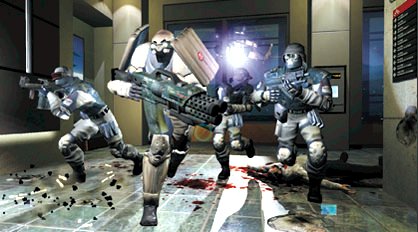Making Experiences
Insight from former Half-Life 2 Developer and head of Monolith, Rick Ellis

While I work in the “games industry,” what we create are experiences, not “games.” Chess and Crazy Eights are games, but these types of games won’t scare the hell out of you, make you jump in your seat, or make you feel responsible when your sidekick dies.
We build a form of entertainment where you as a player are partially in control of the experience, and we as the developer are partially in control as well. Through the use of visuals, artificial intelligence, and targeted audio, we get to play with your emotions, get you attached to characters, provide the unexpected, and influence your heart rate. When we do our jobs well, you forget that you are playing a game, and the events in it feel very real and matter to you. I first felt this playing DOOM and Thief. The tension of sneaking around and being jumped by a zombie, or being seen by a guard, was startling. Shotgunning demons (even if they were sprites) in DOOM was nothing short of nightmarish. These experiences stick with me even today and are constant reminders that this is what “games” are all about: immersion, escapism, and creating emotional believability.
It’s all about the experience. The major difference between a “good” game and a “great” game is how well the experience has been pulled off. There are many things that can ruin the experience and this is where the expertise of the developer really shows. In general, anything that’s out of place or doesn’t “seem right” to the player degrades their experience or sense they are really in the game and not sitting in a chair looking at a TV or monitor. This doesn’t mean everything has to be realistic, it means that every part of the game must fit in and make sense with the environment and setting of the game.

A balance of atmospheric tension, inventive firepower, and smart enemies, F.E.A.R. showed shades of Thief and DOOM
Crafting these experiences is very hard—we’re not building toasters that are recognizable by most people and are easy to specify features for: 4 bread slots, 5 heat settings, and a 6 foot power cord. We have to build an enormous amount of content, throwing much of it away because, frankly, many ideas that sound great on paper simply suck when they are implemented. The best game experiences are carefully crafted with a very high quality bar and a mantra of “it has to be great, or it gets cut” to ensure that the experience you have is unlike any other.
The ability to interact with our players and fans in this manner is what I find exciting about this form of entertainment. With every year that passes, we create and are given better tools and technology to play with your emotions. The next time you are playing and have a strong reaction to a game, as you walk away from your experience, know that somewhere, there is a developer with a Joker-like grin on his or her face, basking in the knowledge that their work made you jump, scream, or cry.
December 17, 2008
Weekly digests, tales from the communities you love, and more


